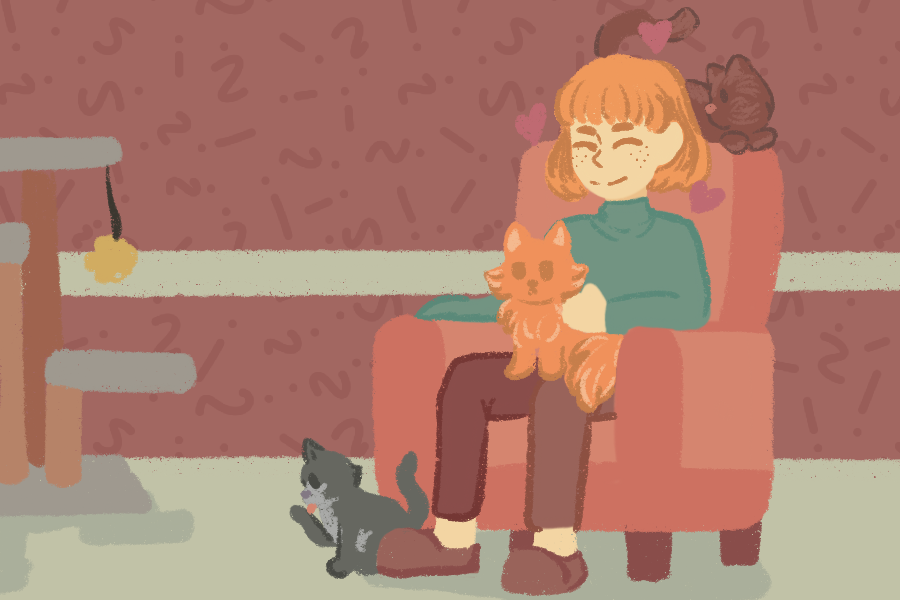The month of December is recognized in the U.S. as National Cat Lovers Month. Celebrating an individual’s cat this month may be an essential part of the cold season. Cat owners may buy their cats a new toy or some catnip and show extra gratitude for their furry friends.
Cats have been human companions since ancient Egyptian times and are one of the most popular types of pets. Statistics show one of the most popular cat breeds in recent years in the U.S. is the ragdoll, with the Cat Fanciers’ Association naming the ragdoll as the number one most popular breed in 2021.
Ragdoll cats are known for their fluffy coats and laid-back demeanor. Ragdoll cats love to play and be held, which could make them a good option for families with young children.
Azariah Sutherland, senior in LAS, lives in an apartment with two cats named Cleo and Harlow and explained why she thinks cats are good pets.
“They have such personalities,” Sutherland said. “They’re like little people, but they’re not, and you have to take care of them. When you compare them to dogs, they’re really independent, but they still have the fervor of a dog that loves you.”
Get The Daily Illini in your inbox!
Sutherland said spending quality time with her cats brings forth positivity in her life.
“My favorite thing is taking naps with them, it’s really peaceful,” Sutherland said. “It feels like a really warm and happy environment.”
Like dogs, cats enjoy playing games with their owners. One game most pet owners are familiar with is fetch. Although typically reserved for dogs, cats can also enjoy this energizing game.
“I didn’t even need to teach Cleo to play fetch, she just does it on her own,” Sutherland said. “She likes these tinsel balls; I’ll throw it and she’ll bring it back.”
Nowadays, the technology at our fingertips can be extended to your four-legged companion. Many game developers have put out various pet-friendly games that you can download for your cat to play. These games pair well with iPads and large tablets.
For aspiring or beginner cat owners, options for cat toys are vast. It can be hard to choose what cat toys to buy and guess which toy the cat will enjoy instead of ignoring.
“Don’t purchase anything unless you know the cat likes it,” Sutherland said. “I had like a whole box of toys Harlow did not use. It depends on the cat. For example, Harlow is very mellow, she prefers little feather toys. Cleo, who’s younger and more energetic, prefers any kind, most of the time toys with little bells.”
Amy Fischer, professor in ACES, shared the importance of providing specific toys that pique a cat’s interest.
“Cats have amazing imaginations, they are historically predators so any toy that gives them the opportunity to be a cat and exhibit species-specific behaviors, whether that’s pouncing, stretching or climbing,” Fischer said. “I personally like the cat dancer toy because they leap and they chase it and are stimulated by it.”
Additionally, Fischer expressed the need for enrichment, particularly for indoor cats.
“Understand that they need to be stimulated, they need so much in their environment to help them engage,” Fischer said. “People think they’re easy pets and that you can just leave food down and go about your business, but they really do benefit from more interaction and more consideration of their enrichment.”
Cats can be known for their occasional destructive behavior, with thousands of social media videos showcasing cats’ playful mischievous nature. It can be tough figuring out how to discipline such independent animals. Cats can be discipline-trained, although it may be a bit more difficult.
“I do training,” Sutherland said. “I’ve been training them to sit and come and give me their paw and stay. It’s a lot of work, but I think I’m doing good on progress.”
Fischer offered tips for preventing unwanted or aggressive behaviors from cats.
“First of all, you would look at what’s causing (the behavior),” Fischer said. “What is in the animal’s environment that might be causing them to react. Look at what might be stressing them out and see if you can change that for them.”
There are also behavior-specific training techniques individuals can practice with their cats, such as desensitization and counterconditioning to try and weed out bad behavior.
In addition to environmental factors, there is always a possibility of underlying medical issues being responsible for a cat’s behavior.
“You always want to rule out any medical problem,” Fischer said. “When animals don’t feel well, they might lash out through biting or aggression.”
It can be difficult to tell when a cat might need to see a veterinarian if the owner is not highly knowledgeable about typical pet behavior. Fischer explained how to spot the telltale signs a cat might be sick.
“Cats are very stoic so we don’t always see them displaying outward signs, it’s going to be more subtle,” Fischer said. “A lot of the postures they exhibit might tell us that they’re not feeling well. Any change in how much they’re sleeping, interacting with you, vocalizing, any change that you can’t explain might tell you that he needs to go to the vet.”
Fischer recommended cat owners check out the Fear Free website to learn more about their animals.
“Fear Free is kind of this movement that helps us really appreciate what animals are trying to communicate,” Fischer said. “That website walks cat and dog owners through, ‘If my cat has a certain body posture what does that mean?’…. Whether their ears are down, whether their tail is down, whether their hair is puffed, everything means something.”
Fischer offered advice to first-time cat owners about the importance of acknowledging the large responsibility committing to a pet could be.
“Always do your research, as with any animal,” Fischer said. “Understand what your animal is going to need, what their species-specific behaviors are and do your best to recreate that in your home. Let your cat tell you what (they) like.”










